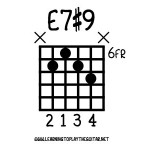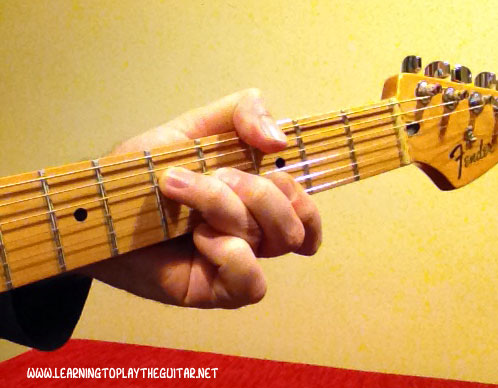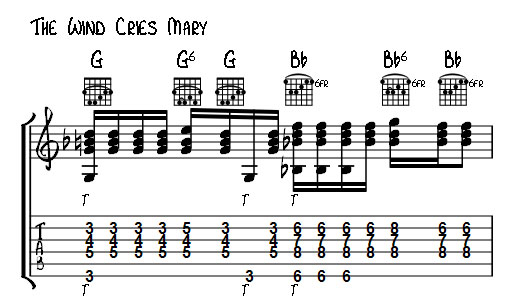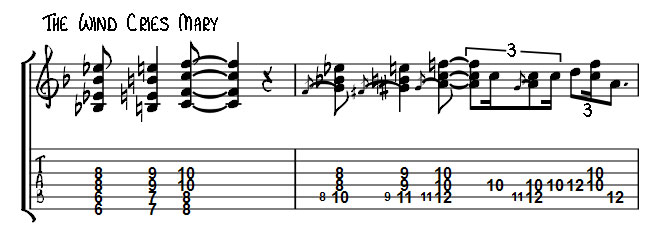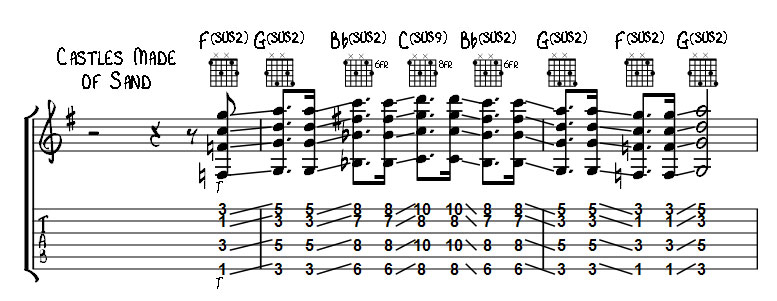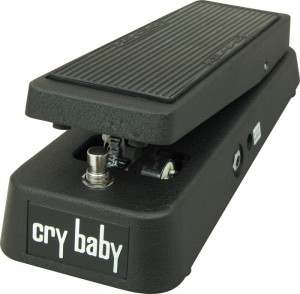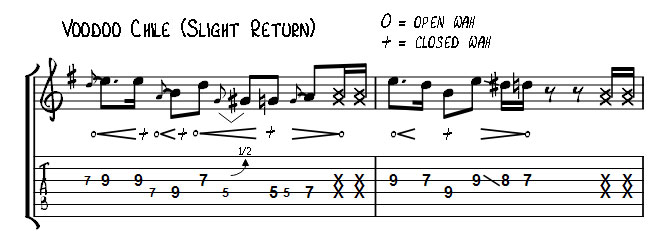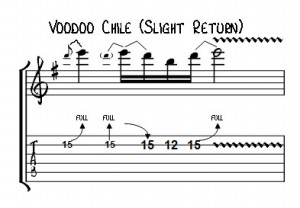Jimi Hendrix is one of the most influential guitarists in the history of rock music. He revolutionised rock n roll guitar incorporating the use of effects such as fuzz, wah-wah, octavia, feedback and more. He also had great rhythm and lead guitar technique which can be heard in his music ranging from quiet ballads to aggressive rock. His style of playing paved the way for hard rock, heavy rock and metal. However his playing wasn’t just about turning it up to 11!
Here we will look at 7 essential techniques for every guitarist to learn and how they were used in some of his most famous songs.
Purple Haze
1. E Minor Pentatonic Scale with Vibrato, Bends & Slides
Image how futuristic this tune would’ve sounded when it was released way back in 1967. The hard fuzz tone the guitar jumps right out at you with the angular intro riff. This riff uses the E minor pentatonic scale and is based on the blues. Listen to the techniques used here including the vibrato, ¼ note bends and slides that bring the riff to life.
2. The Hendrix 7#9 Chord
This song also incorporates another essential element of the Hendrix sound – the 7#9 chord. This chord is based on the 9th chord which in turn is based on the dominant 7th chord. The regular 9th chord is the “James Brown” chord used on tunes like Sex Machine and many other funk tracks.
The 7#9 chord raises the 9th note of the chord a semitone which gives it an edgier sound which is a great for sound for rock music. In Purple Haze Hendrix uses an E7#9 chord in the verse with the #9 note in chord being a G note which comes from the minor pentatonic scale that is used in the riff.
The Wind Cries Mary
2. Chord Embellishments With The Thumb
This more mellow tune shows the subtler side of Hendrix’s playing. Here he plays what is sometimes called a “piano style” of playing. Here he uses his thumb over the top of the neck to play bass notes on the 6th string. This frees up the 4 fingers on the fretting hand to play chord embellishments such as 6ths and 9ths. In the chorus of Wind Cries Mary he uses this technique to play embellishments on the G and Bb chords. Be careful here to also mute the 5th string with either the tip of the thumb or the edge of the 3rd finger.
4. Double & Triple Stop Hammer-Ons
In this song he also makes extensive use of double (and triple) stop hammer-ons within the chords. In the intro you can hear these when he plays the higher versions of the Eb, E, F chords and sometimes in the fills he plays at the end of this riff which is based around the F chord.
Hendrix uses these techniques in his other ballads including Little Wing and Castles Made of Sand.
Castles Made of Sand
5. Sliding Chords
This song features an intro using sliding sus2 chords where Hendrix plays the chord then slides the chord shape to the next position along the neck. Guitarists such as Steve Vai have adopted this technique into their own style of playing. The slide makes the chords much more expressive then simply strumming each chord individually. Also note the use of the thumb again playing the bass notes on the 6th string.
Voodoo Chile (Slight Return)
6. The Wah-Wah Pedal
This blues rock track for the 3rd Jimi Hendrix Experience album Electric Ladyland features the heavy use of the Wah-Wah pedal in the intro. Later heavily used in 70s funk guitar the Wah-Wah was fairly new invention at the time. It works by changing the tone of guitar from low to high mid frequencies when the foot is rocked back and forth on the pedal. This can give the guitar a “talking” sound. This intro riff and the rest of the song is based around the E minor pentatonic scale.
7. Blues Based String Bending
After the Wah-Wah intro the tune really takes off with some very aggressive blues based playing featuring lots of string bending. The technique of bending strings on the guitar comes from blues guitarists emulating singers and how they bent into notes for a more expressive sound. Check out the video below for essential string bending technique tips.
Hendrix only had a brief recording career of 4 years but in that time his mastery of the guitar and use of these techniques changed the sound of rock music paving the way for many guitarists. If you can learn these 7 essential guitar techniques they will serve you well in a range of styles including rock, blues, funk, soul and heavy/hard rock.
All lyrics and chords on this website may only be used for educational purposes, private study, scholarship or research.



